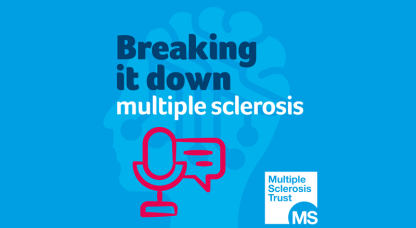What do you do when the disease modifying drug (DMD) you've chosen isn't working? In this guest blog, Lauren shares her thoughts around choosing an MS treatment and what it is like having to change to a new one.
Choosing a disease modifying drug: Lauren's Story
13 November 2018
DMD’s terrified me from the very moment I knew they existed. Everything about them seemed scary and intimidating. There were so many choices. I walked out of my appointment with my MS nurse with an arm full of leaflets and booklets and a head full of confusion. The choice I was faced with seemed huge, and the fear of making the wrong decision swallowed me up whole.
My first course of action in my DMD research was to turn to the internet. There was so much information to sift through. I read for hours about other people’s experiences, and what I quickly learned was that there are no clear answers when it comes to DMD’s. What may have worked for one person didn’t work for another. So I decided to take comfort in statistics. Numbers relating to disease progression and relapse rates suddenly became very important to me. I’d recite the figures I’d memorised to my family at any given moment, and even though I’ve always hated maths, I was convinced the answers lay in the statistics. I weighed up the chances of success against potential side effects to make my choice.
In the end I decided to go with Copaxone. Which was a bit ironic, as needles make me want to faint, and this was the only DMD which had to be injected daily (the three times a week version wasn’t quite out yet). I felt the side effects for Copaxone were acceptable and I also liked the fact that Copaxone had been around for quite a while. As I was still quite young (25), I was thinking about long term side effects as well as the present. The needle phobia took a backseat as I learned how to self inject. Incidentally, I decided to skip the auto-injector. After seeing my MS nurse demonstrate, I felt being able to control the needle at my own speed was preferable, rather than the harsh jab from the auto-injector.
The injections quickly became a part of my daily routine. I was so lucky my Mum was able to help me with the places I struggled to reach, such as the backs of my arms. The injections sometimes stung, and I was always left with a sore, itchy lump for 5 or 6 days, which would just about disappear before it was time for another injection on that site. The soreness was something I could ignore, as was the swelling, but the itchiness was horrible. I tried to ignore it the best I could and just thought about all the good the Copaxone was doing to fight my MS.
As it turns out, it wasn’t doing that much good.
My MRI scan showed new and active lesions. The day I found out I felt crushed. I had been so certain that Copaxone was working. In my mind, a change of medication was the worst thing that could possibly happen. As it turned out, it was the best thing that happened to me since the start of my MS journey.
Thankfully, my new neurologist already had in mind a DMD for me. When she initially suggested Gilenya, I was quite shocked. I knew it was only available if another DMD had failed, and I suppose I hadn’t quite come to terms with that yet. I had invested so much emotionally in Copaxone, and I was feeling quite bitter that it hadn’t worked for me. I knew also it came with a risk of PML. Though the risk was extremely small, it was a risk nonetheless. I’d also need an ECG and would need to be observed during my first dose, as Gilenya can cause changes to heart rate, heart beat and blood pressure.
My day stay in the hospital was wonderfully uneventful. My MS nurse explained that I would need to undergo regular blood tests, especially during the first year of treatment. I decided to take my tablet in the morning each day, and I set an alarm on my phone to remind me to take it. I rely on the ‘Gilenya alarm’ so much, I have never forgotten a tablet so far, but I’m not sure that would be the case if it weren’t for that alarm. As I started getting in to my new routine, I noticed how brilliant it was not to have to inject every day. I hadn’t actually realised how much the constant itching was getting me down until it was gone. The only side effect I noticed from Gilenya was initial hair loss. I was horrified at the time, picturing how I would look bald was not a pretty thought, but thankfully the hair loss stopped after a few months.
The year in between my MRI scans was very difficult. I was struggling to cope with the path my MS seemed to be taking me down. It was becoming impossible to function on a daily basis due to crippling fatigue and other irritating symptoms. As the last MRI result had caught me so off guard, I was determined to be prepared for another DMD change thing time. I was elated to see that Gilenya was working for me.
Gradually I have managed to build up my energy levels. Even though it continues to be an uphill struggle some days, I am doing everything I can to enjoy my life and make the most of the health I have. Who knows, some day I may have to change DMD’s again. If that day comes I will try worry myself about it a little less. Of course I will worry (I think I will always be one of life’s worriers) but I wish I could go back and realise that no-one can give you an answer as to whether a DMD will work for you or not.
Sharing experiences with others in a similar situation can be so helpful, it is such a comfort to know that you are not alone in these situations and feelings, but no amount of numbers or statistics can determine what will happen for you in your journey. Each story is different, but we are certainly not alone in making these important choices.

Latest news & stories
Sign up to updates from us
Keep up-to-date with the latest MS news, explore new research, read the stories of people living with MS, find out practical tips from MS experts, and discover exciting fundraising opportunities
If you would like to sign up for post or telephone (SMS) updates you can complete our sign up form here


